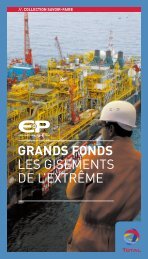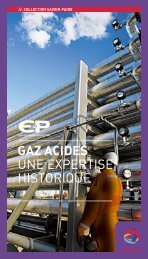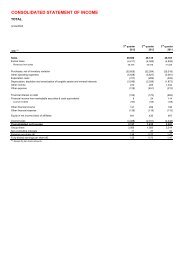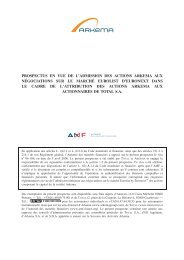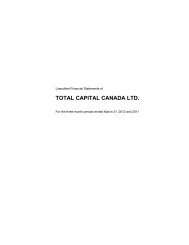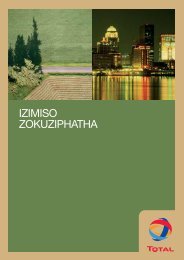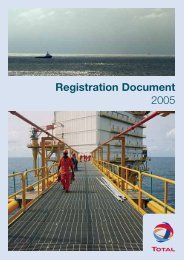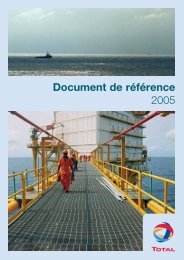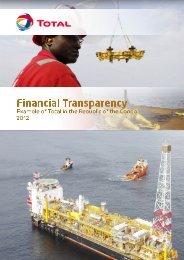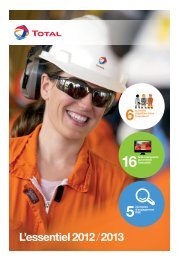Registration document 2007 - Total.com
Registration document 2007 - Total.com
Registration document 2007 - Total.com
You also want an ePaper? Increase the reach of your titles
YUMPU automatically turns print PDFs into web optimized ePapers that Google loves.
The net periodic pension cost is recognized under “Other<br />
operating expenses”.<br />
S. Consolidated statement of cash flows<br />
The consolidated statement of cash flows prepared in foreign<br />
currencies have been translated into euros using the average<br />
exchange rate of the period. Currency translation differences<br />
arising from the translation of assets and liabilities denominated in<br />
foreign currency into euros using exchange rates at the end of<br />
the period are shown in the balance sheet under “Effect of<br />
exchange rates and changes in reporting entity”. Therefore, the<br />
consolidated statement of cash flows will not agree with the<br />
figures derived from the consolidated balance sheet.<br />
Cash and cash equivalents<br />
Cash and cash equivalents <strong>com</strong>prise cash on hand and highly<br />
liquid short term investments that are easily convertible into<br />
known amounts of cash and are subject to insignificant risks of<br />
changes in value.<br />
Investments with maturity over 3 months and less than<br />
12 months are shown under “Current financial assets”.<br />
Changes in bank overdrafts are included in the financing activities<br />
section of the consolidated statement of cash flows.<br />
Non-current debt<br />
Changes in non-current debt have been presented as the net<br />
variation to reflect significant changes mainly related to revolving<br />
credit agreements.<br />
T. Emission rights<br />
In the absence of a current IFRS standard or interpretation on<br />
accounting for emission rights of CO , the following principles<br />
2<br />
have been applied:<br />
• emission rights granted free of charge are accounted for at<br />
zero book value;<br />
• the liabilities resulting from potential differences between<br />
available quotas and quotas to be delivered at the end of the<br />
<strong>com</strong>pliance period are accounted for as liabilities, at fair<br />
market value;<br />
• spot market transactions are recognized at cost in operating<br />
in<strong>com</strong>e;<br />
• forward transactions are recognized at their fair market value<br />
on the face of the balance sheet. Changes in the fair value of<br />
such forward transactions are recognized in operating in<strong>com</strong>e.<br />
U. Non-current assets held for sale and discontinued<br />
operations<br />
Pursuant to IFRS 5 “Non-current assets held for sale and<br />
discontinued operations”, assets and liabilities of affiliates that are<br />
held for sale are presented separately on the face of the balance<br />
sheet.<br />
Appendix 1 – Consolidated financial statements<br />
Notes to the consolidated financial statement<br />
Net in<strong>com</strong>e from discontinued operations is presented separately<br />
on the face of the statement of in<strong>com</strong>e. Therefore, the notes to<br />
the consolidated financial statements related to the statement of<br />
in<strong>com</strong>e refer only to continuing operations.<br />
A discontinued operation is a <strong>com</strong>ponent of the Group for which<br />
cash flows are independent. It represents a major line of business<br />
or geographical area of operations which has been disposed of<br />
or is held for sale.<br />
V. Information related to the first-time application of IFRS<br />
Pursuant to IFRS 1 “First-time adoption of International Financial<br />
Reporting Standards”, the Group has chosen to apply the<br />
following exemptions:<br />
• offsetting currency translation adjustment (CTA) against<br />
retained earnings, as of January 1, 2004;<br />
• recording unrecognized actuarial losses and gains related to<br />
employee benefit obligations as of January 1, 2004 in retained<br />
earnings;<br />
• no retroactive restatement of business <strong>com</strong>binations that<br />
occurred before January 1, 2004;<br />
• retrospective application of IFRS 2 “Share-based payment”<br />
to all transactions within the scope of IFRS 2 and not solely<br />
to the share-based <strong>com</strong>pensation plans granted after<br />
November 7, 2002.<br />
The other exemptions included in IFRS 1 “First Time Adoption”<br />
have not been applied at the transition date to the IFRS or did<br />
not have any material impact on the consolidated financial<br />
statements.<br />
IAS 32 “Financial Instruments: Disclosure and Presentation” and<br />
IAS 39 “Financial Instruments: Recognition and Measurements”<br />
have been applied as from January 1, 2004. The Group has<br />
decided on an early application in 2004 of IFRS 6 “Exploration for<br />
and Evaluation of Mineral Resources”. This standard is<br />
<strong>com</strong>patible with previously used methods to record exploration<br />
and production costs (see note 1H to the consolidated financial<br />
statements “Oil and gas exploration and producing properties”).<br />
Description of the effects of the transition to IFRS on the net<br />
equity and the results of the Group were provided for in the 2005<br />
<strong>Registration</strong> Document. This information is presented in the note<br />
32 to the consolidated financial statements as of<br />
December 31, 2005.<br />
The financial data for 2004 and 2003 were presented under<br />
French GAAP in the 2004 <strong>Registration</strong> Document.<br />
9<br />
W. Alternative IFRS methods<br />
For measuring and recognizing assets and liabilities, the following<br />
choices among alternative methods allowable under IFRS have<br />
been made:<br />
TOTAL – <strong>Registration</strong> Document 2006 179




